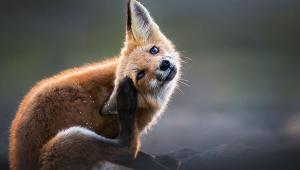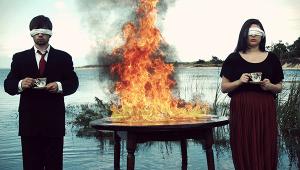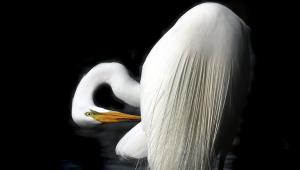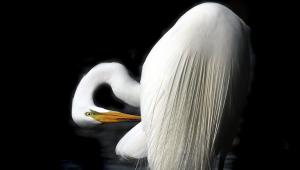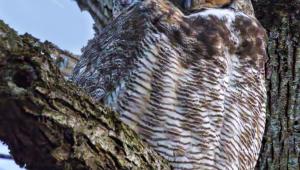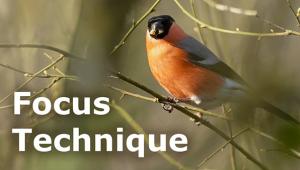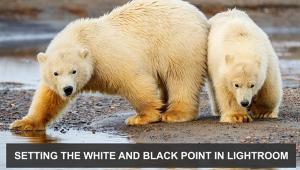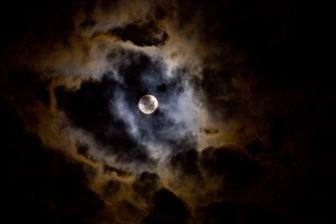Shorebreak Shooting: The Photography Of Clark Little
He stands in about 3 feet of roiling surf, wetsuit jersey glistening from repeated dunkings. The sky above Oahu’s North Shore is deep blue. Undertow currents grasp his legs—eroding sand beneath his swim fins—as water rushes seaward to build the next huge wave. He holds his bulky waterproof camera housing tightly, faces west toward the setting sun and checks the long tether attached to his wrist. He turns his head to watch the wave rise ever higher—a towering blue-green monster that’s starting to curl, white spume blowing off its top. He braces himself as best he can against the forces raging around him, points the camera toward the golden Hawaiian sunset, and waits as tons of water begins to curl over him, forming a tube. At what he hopes is the right instant, he fires off several shots and prepares to be pounded and rag-dolled by the massive wave.
Welcome to Clark Little’s studio.
Hawaii resident Clark Little has carved out a unique, challenging, and dangerous niche in the world of photography. Since 2007, he has established himself as the world’s preeminent practitioner of “shorebreak” photography. He may well have created the genre.
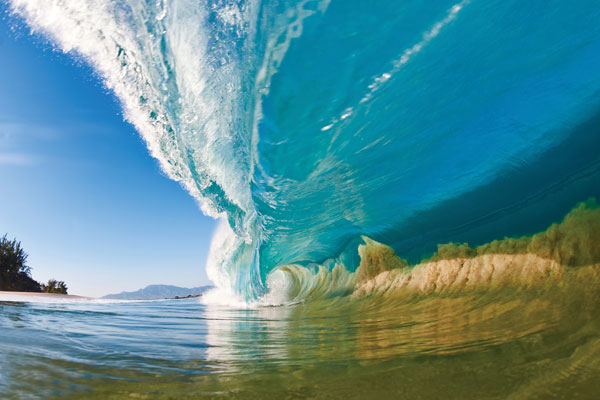
Location: North Shore, Oahu, Hawaii
This image was made in the middle of the day with lots of direct sunlight. The large North Shore wave makes its way onto a shallow sandbank. As the wave throws itself up and outward, it sucks the sand off of the seafloor into the wave itself.
All Photos © Clark Little
Little has lived on Hawaii’s North Shore, a world-renowned surfer’s paradise, since he was a child. In the 1980s and ’90s he was a pioneer in surfing Waimea Bay’s shorebreak where waves can reach up to 25 feet in height. Little developed a talent for taking off on “hopeless” shorebreak waves and surviving in one piece.
“I must confess that I’m an adrenaline junky and really love the rush of getting tossed and tumbled in waves,” Little said. He became well known for his daredevil surfing antics, even winning an award one year for the worst wipeout.
Though his dad taught photography at Leeward Community College for 22 years, Little didn’t develop an interest in the medium until 2007 when his wife brought home a picture of a wave to hang on their bedroom wall. He looked at the photograph, told her he could get a better shot himself and had her return it to the gallery. He bought an inexpensive digital point-and-shoot and waterproof housing. With the confidence of an experienced surfer, he jumped into the North Shore’s pounding surf and began recording waves from the inside out.

Location: North Shore, Oahu, Hawaii
When the waves are smaller, the endangered green sea turtles (known as “honu” in the Hawaiian language) come close to shore to feed on the seaweed. Little waits behind a breaking wave for the moment when the turtle escapes the danger. This turtle, dwarfed by a large wave breaking over its back, is probably pushing its luck too far.

Location: Makena Beach, Maui, Hawaii
Shot in the early morning and with a strobe flash, this silky and smooth tube looks like a piece of blown glass. Calm days in the islands are called “glassy” for this obvious reason.
Little said that being a professional photographer was the furthest thing from his mind when he started shooting waves. For 17 years he was a supervisor at the Wahiawa Botanical Gardens, specializing in native and tropical plants. He was planning to stay until retirement, but, seeing that he was able to sell his prints, he took the “plunge” and resigned to pursue photography full-time. In the six years since, Little has gained worldwide recognition for his wave images with exhibitions in Japan, Brazil, and throughout the US. He has appeared on television programs including Good Morning America, Inside Edition, The Today Show, Daily Planet on the Discovery Channel, and NHK in Japan.
His work has been exhibited at the Smithsonian Museum, Alden B. Dow Museum, Science Museum of Virginia, Parco Logos Gallery in Tokyo, The Four Seasons and The Ritz-Carlton Resorts, and published in National Geographic, New York Times, Life, Nikon World, Paris Match, Outdoor Japan, Sierra, Geo, Nature’s Best Photography, Rangefinder, and Surfer’s Journal among others. His commercial clients include Apple, Hurley/Nike, Nikon, Hewlett-Packard, Toyota, Anheuser Busch, Lockheed Martin, Verizon, and XS Energy Drink.

Location: North Shore, Oahu, Hawaii
The entrance to the tube and the setting sun are positioned to light the wave up with golden accents. On days with no wind, the water surface is like glass.

Location: North Shore, Oahu, Hawaii
Little’s favorite time to shoot waves is the early morning. The winds are usually calm, keeping the surface of the water smooth. There are no crowds. And the world goes from dark to light, with the sunrise providing magic lighting.
In 2009, Little published a 182-page debut art book, The Shorebreak Art of Clark Little. In 2011, he opened the Clark Little Gallery in his hometown of Haleiwa, just down the road from many of the North Shore beaches featured in his photography. Also in 2011, he received the Oceans Photography Award from the Windland Smith Rice International Awards presented at the Smithsonian National Museum of Natural History.
Since shorebreak photography was essentially new-to-the-world, Little had to learn his craft largely through trial and error.
“One of the most obvious techniques for capturing views of waves from the inside is putting yourself in the right place at the right time,” Little said. “The key is to get in the critical section of a wave and stay there until the last possible second when a ‘tube’ forms. The tube is a cylindrical air pocket formed when a powerful wave hits a shallow bottom, forcing it to throw the water up, over, and out. Tubes only survive for seconds, so the window of opportunity is narrow.”
Little noted that waves move quickly and are unpredictable, so he has to react quickly, watching each wave form and break, using insights developed from years of surfing the large North Shore rollers. The waves he shoots usually break in shallow water. When they break, they detonate like an explosion.

Location: North Shore, Oahu, Hawaii
Captured at the moment when two waves collide, a fan of water is thrust up in front of the sunrise. This image is one of Little’s most iconic shots, appearing as a two-page spread in “National Geographic” magazine in 2010.
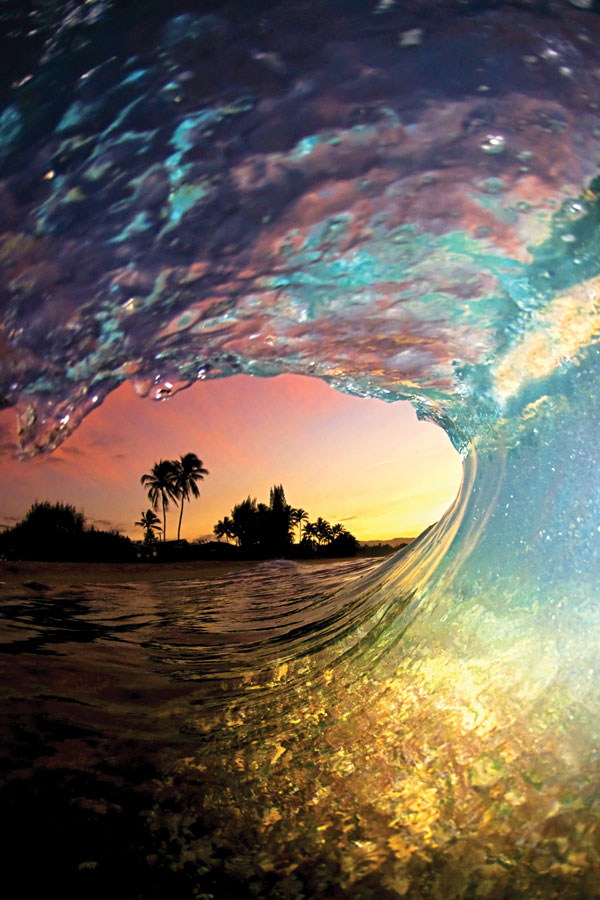
Location: North Shore, Oahu, Hawaii
This was taken at sunset using a strobe flash placed within the wave. Where the light from the flash ends, the colors from the sunset start to fill in. It is named after the shaved ice snow cone flavor that includes all of the major colors.
Little’s techniques for surviving surfing wipeouts, mastered from years of riding waves, help him survive the pressure and rag-dolling effects that come with photographing in this turbulent zone. He stays in good shape so he can swim and move quickly with his 8-lb waterproof camera setup. When he goes out, he might be in the water for one to four hours at a time, with the longest stretches up to five hours. So endurance is critical. But he does not do any special training, except for the occasional jog in his neighborhood. Strenuous activities in the surf are sufficient to keep him in shape.
Obviously, Little’s photographic pursuits are dangerous with the potential for serious injury or drowning. On the seven-mile stretch of North Shore beaches where he shoots, there are seven lifeguard stations that perform over 200 rescues a year, more than 150 for serious medical emergencies. In the last few years, Little has helped rescue others in trouble about a dozen times.
“I’ve not suffered a serious injury yet. But I have had some close calls,” Little said. He separated his shoulder in 2011, has injured his knees, and has had a few gashes on his face from being hit by the camera.
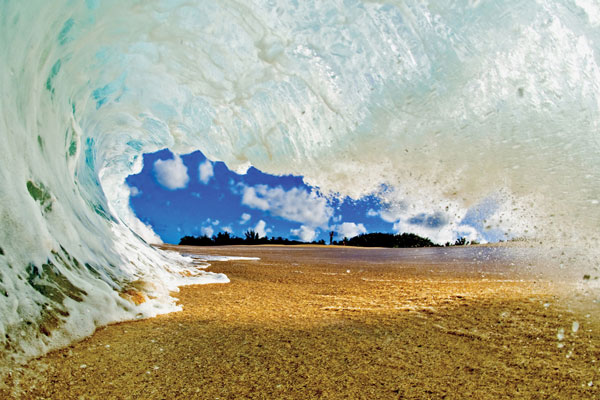
Location: North Shore, Oahu, Hawaii
This is the cover shot of Little’s debut coffee-table book, “The Shorebreak Art of Clark Little.” Little is lying on the sand to make the image. The location is so shallow that the wave sucked away the water leaving dry sand. Since there was no water to allow him to escape, when the wave crashed down, it sent him rolling 20 yards up the beach, covered in sand from head to toe.
“I always seem to have a bruise or scrape somewhere. There have also been moments when I’ve been held underwater too long and have been on the verge of blacking out. But luckily, nothing has been so bad that I couldn’t be back in the water in a few days.”
The biggest danger is being hit by the camera if he loses his grip. That’s why he attaches it to his wrist with a tether long enough so it will usually float free and away from his body.
Considering the physical demands and bodily wear and tear, how much longer will Little challenge the waves of Waimea’s North Shore? “Right now I am in my zone and can’t imagine photographing other subject matter. I won’t count it out, though. One thing is for sure, it would have to be pretty exciting. I need the rush. But, for now, I’m finding almost infinite possibilities in shorebreak photography. Each wave is like a snowflake—unique.”
Tool Kit
* Nikon D300s, D3, and D4 cameras
* Nikkor Fisheye 10.5mm and 16mm lenses
* Waterproof housings by Water Housings Hawaii
* Churchill swim fins (Makapuu model)
* Hurley wetsuits
* One cup of coffee in the morning with two shots of espresso
“The Shorebreak Art of Clark Little”
Clark Little’s debut photography book, 182 pages (12x12”), with over 100 photos includes 75 two-page spreads and forwards by singer/songwriter Jack Johnson and 11-time world champion surfer Kelly Slater. The book is available online at www.clarklittle.com.
To see more of Clark Little’s shorebreak photography, visit www.clarklittle.com.
- Log in or register to post comments











